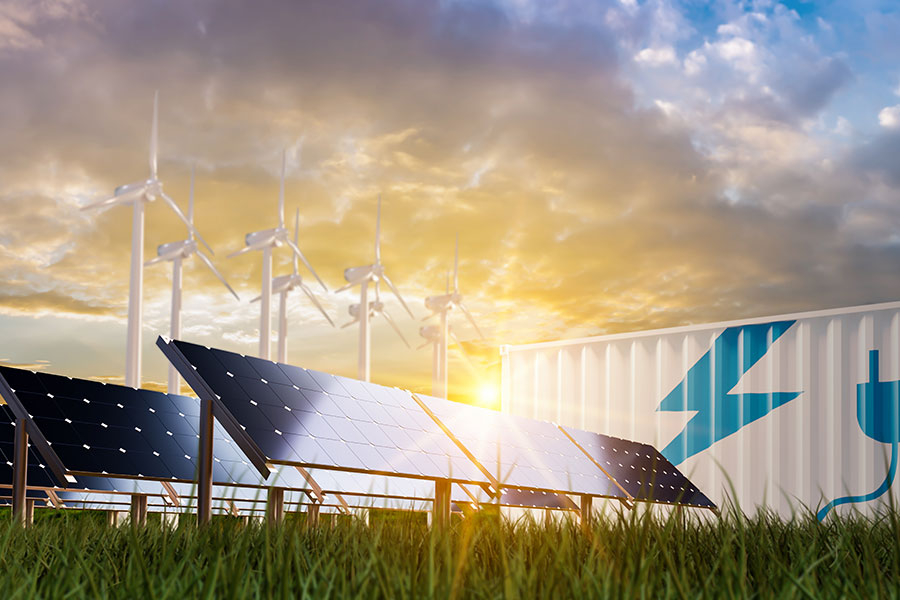
Leaving Climate Change in the Past: Building a Clean Energy Future with Long-Duration Energy Storage
By Mark Higgins
Unprecedented times call for unprecedented solutions and big thinking. The recent surge in global climate awareness not only brings to light the opportunities for clean energy advancement, but also the potential for growth across the industry. Global greenhouse gas (GHG) emissions continue to rise; according to the Intergovernmental Panel on Climate Change (IPCC) AR6 Synthesis Report, “Net GHG emissions have increased since 2010 across all major sectors,” causing mass devastation to fragile ecosystems. In addition, there are many barriers to entry for newly designed or in-development technologies that have the potential to eliminate carbon emissions. Further, many cleantech solutions are immature, not yet commercially viable, or years away from becoming significantly scalable.
Overcoming these challenges will require innovative, cost-effective, and eco-friendly solutions with strong systemic support. While steep declines in GHG emissions may seem like a Sisyphean feat, commercially proven solutions exist that just need to be rapidly scaled. One of the key solutions to unlock large-scale decarbonization using commercially validated technology is long-duration energy storage (LDES). Defined by the duration of dispatch, typically 8-10 hours or more, LDES systems utilizing safe and sustainable chemistries are economically feasible and scalable for much-needed widespread deployment. As formidable as each challenge may be, the benefits of LDES can deliver flexible and adaptable solutions. And LDES is commercially proven and ready to scale to meet this global challenge.
Challenge 1: Total decarbonization
Drastically reducing GHG emissions is a long-standing issue requiring large-scale action. Existing and emerging data consistently confirm the dangers of GHG emissions. The IPCC report states, "to limit global warming to the relative safety of 1.5° C, the world’s emissions must reach net zero in the early 2050s and decrease further thereafter.” Species loss, heat humidity risks, and food production impacts are just a few of the dangers associated with prolonged climate change. The IPCC report additionally states, “more than 3 billion people already live in areas that are ‘highly vulnerable’ to climate breakdown and half of the global population now experiences severe water scarcity for at least part of the year.”
Solution 1: Proactive steps
To mitigate the detrimental effects of GHG emissions, all sectors must take proactive steps. These include setting – and sticking to – net-zero emissions goals, dedicating funding to emissions reduction, and focusing on investments to support the deployment and implementation of LDES projects. Bringing awareness of the dangers of climate change and the opportunities LDES implementation presents to policymakers, stakeholders, and large organizations is critical to ensuring a positive outcome in the fight for net zero. Corporations alone won’t be in a position to drive this at scale – government policy is required to align corporate profit objectives with environmental outcomes – this can come in the form of both regulations and economic incentives. The Inflation Reduction Act in the United States is an excellent (if imperfect) example of a government attempting to do just that.
Challenge 2: Barriers to progress
Current technologies that seek to eliminate GHG emissions have several hoops to jump through before becoming a viable alternative to existing energy infrastructure. For example, the most common battery technology on the market, lithium-ion, presents well-documented environmental risks, health hazards, supply chain constraints, and longevity issues. Between raw materials scarcity, price volatility, supply chain stress and ethics, fire hazards, limited recyclability, and competition with the rapidly growing electric vehicle market, lithium-ion energy storage is a less than ideal option for universal deployment on the power grid.
Also, a low commitment to embracing net-zero initiatives by many large corporations – some of the world’s largest emitters of GHGs – leaves much to be desired, particularly when such stakeholders can deliver a significant amount of positive change. Even those companies with aggressive public goals often lack the internal focus and commitment required to be successful. According to Accenture, “More than a third (34%) of the world’s largest companies have a public net-zero target; nearly all (93%) will fail to achieve their goals if they don’t at least double the pace of emissions reduction by 2030.”
In addition, transitioning a multi-trillion dollar global infrastructure network designed for fossil fuels is a time-consuming, incredibly costly process. To make this shift a reality in the necessary timeframe, the IPCC report identifies the need for “coal power [usage to drop] globally by 87% by 2030 and by 96% by 2035, which would entail replacement of virtually the whole power fleet within a decade in coal-dependent developing countries.” This is a particularly challenging goal given that many developing countries don’t have sufficient resources or technical expertise to conduct grid planning on such a massive scale without significant outside assistance.
Solution 2: Actionable effort
Breaking down the barriers outlined above requires actionable effort from a broad range of stakeholders, including technology providers, large organizations, non-governmental organizations, trans-national organizations such as the World Bank and IMF, and both developed and developing countries, regional and local governments. Opting for more cost-effective, environmentally friendly LDES batteries over lithium-ion where longer duration is required makes deployment safer and less restrictive. Increasing the urgency for large organizations to adopt – and execute – net-zero initiatives is also crucial to significantly curtailing GHG emissions. Some signs are encouraging. Support is growing steadily for new and existing storage technologies, and even more so since the passing of historic climate legislation. This includes the Inflation Reduction Act in the U.S. and other global policies like Australia’s Climate Change Bill 2022, legislating the nation's commitment to reduce greenhouse gas emissions by 43% below 2005 levels by 2030, and net zero by 2050. But more action is required, particularly at the trans-national organization level, and in particular, financial support for developing nations’ GHG reduction goals from the developed world.
Challenge 3: Finding the right chemistry for large-scale development
The current range of clean-energy and energy storage technologies, including lithium-ion batteries, are insufficient to meet total decarbonization goals. Reducing carbon emissions in an effective, scalable, and affordable fashion will also require long-duration storage solutions using different chemistries that are reputable, tested, stress global supply chains less than that of lithium-ion, and are feasible for large-scale deployment. According to the DOE Liftoff report, to decarbonize completely, “the U.S. grid may need 225-460 GW of LDES capacity for power market applications for a net-zero economy by 2060.” To put that into perspective, the International Energy Agency (IEA) reports that globally the “total installed grid-scale battery storage capacity stood at close to 16 GW at the end of 2021,” the majority of which is short-duration lithium-based storage. Major players in the LDES market still only have a very small fraction of the overall market for energy storage, but as markets for LDES emerge that make longer duration applications cost-effective, these companies are winning larger orders, and ramping up manufacturing capacity to meet growing demand.
Solution 3: Safe, cost-effective, and commercially proven LDES solutions
The balancing act between rapid, large-scale LDES deployment that is safe, cost-effective, and commercially proven is where companies like Redflow step in. Redflow’s zinc-bromine flow battery is an ideal LDES solution to combat the harmful effects of climate change on a large scale, with many benefits and an unparalleled commercial track record, with more than 250 commercial deployments worldwide and substantial operational performance data to support financial underwriting.
Redflow’s Zinc-bromine battery chemistry is well-suited for many current and emerging applications, allowing for:
- Long duration time-shifting of energy on a daily basis, enabling 24/7 clean energy on all but a handful of days per year when the renewable resource falls short;
- Providing resilience and emergency power supplies in a wide range of climates, enabled by Redflow’s unique hibernation mode that allows our batteries to retain a full state of charge indefinitely;
- Abundant, widely available raw materials with robust supply chains and an ability to source locally in most major markets, supporting local supply chains and energy security;
- No risk of thermal runaway, made with non-flammable materials, verified to UL9540A;
- Long-life, multi-cycle design with the ability to value stack just like lithium-ion – performing frequency control and energy shifting.
Climate change is an imminent threat to people and our planet. Reversing and preventing the negative impacts will require rapid, extensive action in the form of sustainable clean energy solutions – including long-duration energy storage. There are numerous systemic challenges, between the continued rise of greenhouse gas emissions, barriers to market entry, and the relatively limited manufacturing capacity of LDES providers today, that must be overcome to play a significant role in decarbonization. Sustainable, scalable long-duration energy storage systems, like Redflow’s, are truly viable, cost-effective, and commercially proven solutions for achieving ambitious net-zero targets and securing a clean energy future.

+ 61 7 3376 0008
[email protected]
Hey there, this is the default text for a new paragraph. Feel free to edit this paragraph by clicking on the yellow edit icon. After you are done just click on the yellow checkmark button on the top right. Have Fun!